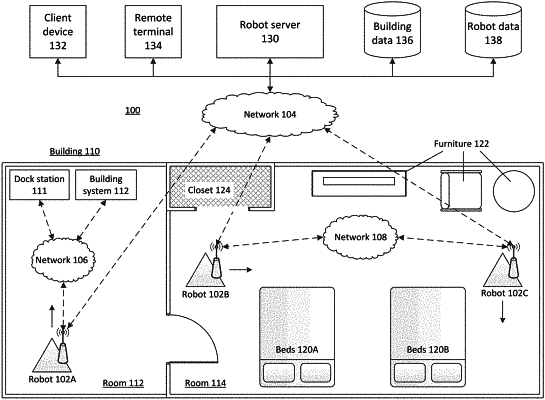| CPC G08B 21/182 (2013.01) [B25J 9/163 (2013.01); G08B 21/20 (2013.01); G08B 25/007 (2013.01)] | 14 Claims |

|
1. A method for generating an alert associated with activity of a mobile cleaning robot in a fleet of mobile cleaning robots, the method comprising:
receiving contextualized sensor data from the mobile cleaning robot via a network, the contextualized sensor data comprising location data indicating a location of the mobile cleaning robot and sensor data obtained by the mobile cleaning robot representing sensed conditions of an environment associated with the location;
accessing staff member data associated with each of a plurality of staff members from a staff member database, each of the plurality of staff members associated with a member-specific multiplier;
accessing a set of stored alert rules for managing alerts associated with the fleet of mobile cleaning robots, wherein a rule specifies alert criteria for triggering the alert associated with a target staff member of the plurality of staff members,
wherein the alert criteria is based on a state of the mobile cleaning robot with respect to one or more cleaning tasks assigned to the mobile cleaning robot, and
wherein the alert criteria for the rule specifies that the rule only triggers the alert associated with the target staff member when the contextualized sensor data exceeds a member-specific alert threshold for the target staff member computed as a product of the member-specific multiplier for the target staff member and a dynamically configured global alert threshold;
determining if the contextualized sensor data and the state of the mobile cleaning robot meets the alert criteria associated with the target staff member based at least in part on comparing the contextualized sensor data to the member-specific alert threshold;
responsive to determining that the contextualized sensor data meets the alert criteria for the target staff member, generating an alert for the target staff member;
transmitting the alert to a client device associated with the target staff member;
tracking, a response time of the target staff member to the alert comprising a duration of time between transmitting the alert and an alert flag associated with the alert being reset;
performing a comparison of a set of historical response times associated with the fleet of mobile cleaning robots to a response time threshold; and
adjusting the dynamically configured global alert threshold associated with the rule that triggered the alert based on the comparison to increase a frequency of triggering the alert responsive to the set of historical response times being lower than the response time threshold and to decrease the frequency of triggering the alert responsive to the set of historical response times being greater than the response time threshold.
|